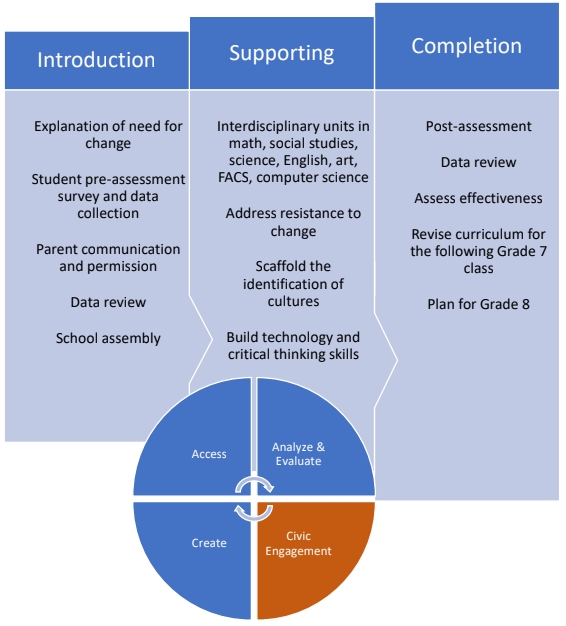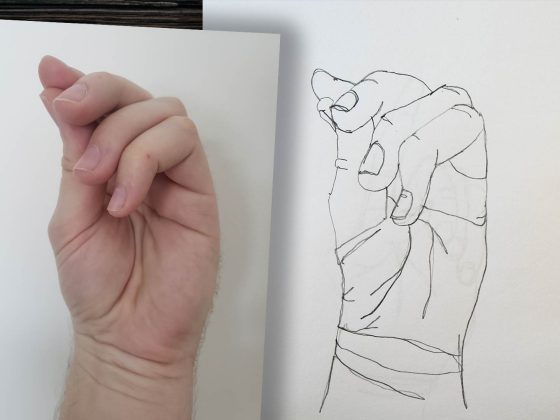This was a plan created for my master’s in educational technology. During the process, I created a culturally responsive plan to teach students about culture through researching and engaging with their own roots. I chose to use the setup and demographics of my alma mater as the basis for this assignment (I do not work for the Mahtomedi school district and this plan was not written in coordination with ISD 832). It’s a fictional setup, but the plan itself is very solid.
It must also be said that I disagree with numerous conclusions Nieto and Bode reached in the required course reading. I am not advocating for their work, but was required to reference them nonetheless. I did so in my best capacity to remain true to myself and only where their perspective aligned with other research.
Culturally Responsive Plan
This paper will outline a plan to promote student cultural competency for Grade 7 at Mahtomedi Middle School through the embedding of family history in required classes. Student demographics will be explored and rationales to change the current curriculum will be articulated with an identified change through assessment. Measures of effectiveness will be provided through quantitative data and ongoing development will be proposed.
Student Demographics and Need for Change
Mahtomedi Middle School has a population of 3,305 students across its six schools. Racial demographics across the district are broken down as follows: White (83.5%), Black (3.8%), Hispanic (4.4%), Asian (2.8%), and two or more races (5.4%) (Niche, n.d.; Public School Review, 2021). Of these, 835 students attend the middle school with 287 students enrolled in Grade 7 (Niche, n.d.; Public School Review, 2021). According to recent statistics at the middle school level, 9% of students qualified for free or reduced lunch while 22.3% of students were identified as gifted. No further data was readily available to specifically target the population of Grade 7. As the population is largely homogenous, steps will be taken to ensure a diverse array of cultures are fairly represented without concision bias.
Students will learn about other cultures in their Grade 8 geography class. The plan outlined considers the critical skills students need to respectfully engage with diverse ideas and establishes a foundation for students to demonstrate competency in their own cultures before learning about other cultures that might be vastly different from their own. One should not expect a student to understand another’s culture if he does not understand his own. Grade 7 was chosen for this initiative because of students’ cognitive development. According to Piaget’s theory of cognitive development, students at this level are able think logically and rationally and begin to think more about social issues (Cherry, 2020). Nieto and Bode expressed, “Nothing short of a complete restructuring of curricula and the reorganization of schools is required” (2018, p. 41). To this end, this plan should be a part of students’ year-long curriculum embedded throughout their schedules. European American youths often do not think they have a culture while also believing anything outside of their perception of normal is “ethnic” and “exotic” (Nieto & Bode, 2018, p. 38). By the end of students’ seventh-grade year, they should be prepared to interact with different cultures and ideas in the following year’s geography class.

Implementation of the Plan
It must be emphasized that this plan will span the full school year and will be woven into relevant courses. This will reduce the burden of implementation from a single class to a plan fully supported by all teachers. Because all teachers will be engaged with the material, students will receive consistent support throughout the process of their research. To keep this developmentally appropriate, chunking activities will minimize anxiety and allow for more exploration of similar concepts between courses. At the beginning of the year, students will complete a pre-survey form asking them to define “culture” and to describe their own culture. Students will also answer a variety of questions pertaining to the knowledge of their own family history. These surveys will be kept on file for final assessment and to qualitatively gauge effectiveness of this intervention. A rubric and a checklist will be used to evaluate student progress based on concrete criteria to describe each student’s level of understanding of culture and their ability to demonstrate cultural competence with the tasks that follow.
Because technology will be used as a research tool, letters will be sent to families to explain the project and maintain COPPA compliance by receiving permission for students to set up accounts with Ancestry and FamilySearch. To provide free access to students, Mahtomedi Middle School will coordinate with the Wildwood Branch of the Washington County Library to provide Ancestry Library Edition; this step is intentional and is meant to build a relationship between students and their local library. Several alternatives will be offered for students who are unable to maintain accounts for family history. They will be allowed to use an account belonging to the district to search for relatives. If they are not allowed to use Google Drive, they may print original documents and catalog them in a three-ring binder. To work on their family tree, these students will be provided with family group sheets, family tree direct lineage templates, and complete their family tree on larger poster paper.
At orientation, families will receive information to help parents navigate the theme for the school year. During the first two weeks, the school will hold an assembly for seventh-grade students to see a visual overview of the school year. The goal of this is to excite students for their cultural endeavors and introduce them to the idea of culture in a safe, affirming space. Some teachers will briefly talk about their cultures and heritages to provide examples.
The backbone of this plan centers on the development of computer literacy skills. Students will need to know and demonstrate proficiency of an array of tasks that line up with digital literacy skills, such as being able to “access, analyze and evaluate, create, reflect, and act” (Hobbs, 2010, as cited in Lee, 2014, p. 31). This same research shows positive correlations between operational, usage, communication, and creation digital literacies and civic engagement. Computer science classes will be structured to teach students how to: find programs from the start menu; open, close, minimize, and maximize windows; navigate the computer’s file structure; use and know the mouse buttons; create, save, delete, and rename files; undo; copy and paste; search for information; upload and download files; manage files in the cloud; use email and other online tools to communicate and curate; and create and manage folder hierarchies (Lee, 2014, p. 36). Most importantly, students will develop the confidence with computers to find, move, and organize family history documents they download. Students will also learn civic engagement skills to fact check and use critical thinking, especially when determining if a person they find in records truly is a part of their family. Computer science classes will also help students create accounts on Ancestry and FamilySearch and begin the process for building family trees. Although a linear process, support will need to be provided for students with more complex branches.
Two classes will begin building skills for research. In art, students will learn how to read and write in cursive—a necessary skill to read older documents. Math will teach a lesson on essential logic skills; these tie in with mathematical concepts and apply in various situations. Specific to the goals of this plan, use of modus ponens and modus tollens will help students develop skills for critical processes of elimination.
As students build their trees and save documents, they will be encouraged to keep a journal. This will provide the space to note any questions they might have. Through curiosity, students will begin expanding their critical thinking skills. Curriculum will expand on these concepts throughout all departments, providing opportunities to investigate through inquiry on various activities utilizing different learning styles.
After students have formed a basis for their research, English classes will help students write, conduct, and curate interviews with living relatives. Teachers will conference with students to help formulate and revise questions. After lessons in social studies classes, Students will create cultural passports in English; these will identify various cultural aspects of importance to each student and help them begin to describe their own cultures. English will also be used to organize ideas that will be presented at the world fair at the end of the school year.
Social studies classes will develop linear processing skills for divergent exploration of cultures. Students will build separate timelines of major events in their own families, in America, and in at least two ancestral countries. Students will examine how some events between their cultures intersected and influenced history. Class time will also be devoted to exploring census data to understand the larger cultural context of each family, including religion, profession, and socioeconomic clues. Students will research one culture specific to his or her own heritage and become experts on their people, including some of the hardships that were faced and reasons for immigration. Lastly, social studies will implement a mock Ellis Island immigration experience to place students in the mindsets of what immigration was like, including filing petitions for naturalization with the teacher.
Math classes will continue the study of immigration by analyzing influx statistics compared with the total population. Students will create line graphs to show each immigrant group over a span of years. This will also help to dissolve myths about immigration and that it is still part of the American tradition today. Census data will also be explored through exercises about inflation to calculate home and rent values in today’s dollars.
Science and health classes will collaborate to teach DNA inheritance and how genes are passed to each generation. Likewise, health classes will discuss inheritable diseases ranging from biological to behavioral.
Art and family and consumer science (FACS) courses will explore some of the more visible aspects of one’s heritage. These will include researching and preparing cultural dishes. Through creating recipe books, students will discover some of the connections between food and available natural resources that influenced cultures and flavors. Likewise, traditional dress will be researched and sewn. They will compare the cultural attire from older time periods to today and understand the changes in tradition. Ancestral design patterns will be researched in art and implemented in FACS sewing projects. Art styles will allow students to see visual representations and portrayals of cultures, including understanding traits that each culture determined were valuable to include. Gridded drawing will allow students to create memorable keepsakes of family pictures.
At the end of the year, students will present about their discoveries and talk about their own cultures, both historical and current. Small groups will be organized for further discussion to dive deeper into the similarities and differences between cultures that are like and different from their own. In May, Mahtomedi Middle School will host a world fair night where students will recreate various aspects of their cultures in staged villages. They will re-enact history based on professions, attire, and other cultural attributes. Students will also talk about the immigration and assimilation experiences of the cultures they are representing. Technology will be used to create interactive exhibits using laptops and iPads for parents and visitors to further engage with these histories as part of the community. Visitors will receive passports that can be stamped at each re-enacted station. Exemplary projects may be archived into a larger repository at the local library.
Resistance to Change
The aim of this plan is to lessen resistance to change for when students and families engage with the Grade 8 geography curriculum by instituting plans that allow students to explore their own cultures. According to DeWitt (2014), providing students with a base to understand and respect their cultures is as important as teaching them about diverse cultures. This can help students as they grow and learn about other cultures, thus providing a valuable frame of reference for future interactions.
There could be numerous reasons for parents or students to resist learning about themselves. Not every student will come from a nurturing home. Others might be hesitant to participate because of adoptions, divorce, family secrets, or other circumstances that cause shame, grief, or discomfort. Staff will need to be mindful of varying family circumstances and approach each activity with a perspective of care. This initiative must be planned to provide support for these students through school counseling, family health, trauma, and psychology services. Various scaffolds will need to be in place for students who struggle or lack enthusiasm for their own backgrounds. Teachers will want to help these students connect cultural reference points to themes that interest those students.
Assessing Effectiveness and Planning for Ongoing Development
At the end of each school year, the seventh-grade team will meet to discuss the qualitative data obtained from the pre-surveys and the post-surveys. Substantial growth should be noticed in each student’s ability to identify and describe their own cultures. A rubric will be used to track each student’s level of growth, identifying whether each student is proficient at a basic level and clarifying at what level each student is able to demonstrate their knowledge of the concept of culture. This will provide a baseline for the following year’s Grade 8 team to modify and re-teach any essential concepts vital to the construct of one’s culture to provide a frame of reference to discuss diverse cultures from around the world. Parent and student feedback will help shape the following year’s approach for the Grade 7 team.
While strategies will be assessed on an annual basis, professional learning communities will make smaller adjustments in the short-term. These adjustments will help tailor the curriculum to students’ current understandings, interests, and family situations.
Conclusion
This plan helps focus students’ understanding of culture to their own frames of reference. It is a school-wide initiative to create a school culture that welcomes learning about other cultures by validating and valuing students’ own cultures. Thus, students will be able to engage in meaningful dialogues to learn from other students’ shared familial experiences. For immigrant students, the effort aims to prevent the loss of culture due to assimilation while also teaching students that cultures are not fixed but continually evolve with society.
References
Cherry, K. (2020, March 31). What are Piaget’s four stages of development? https://www.verywellmind.com/piagets-stages-of-cognitive-development-2795457
DeWitt, P. (2014, February 25). Teaching students about other cultures…and their own. EdWeek. https://www.edweek.org/education/opinion-teaching-students-about-other-cultures-and-their-own/2014/02
Lee, S. (2014). Digital literacy education for the development of digital literacy. International Journal of Digital Literacy and Digital Competence, 5(3), 29-43. https://doi.org/10.4018/ijdldc.2014070103
Niche. (2020, June 28). Explore Mahtomedi Middle School. https://www.niche.com/k12/mahtomedi-middle-school-mahtomedi-mn/
Public School Review. (2021). Mahtomedi public school district. https://www.publicschoolreview.com/minnesota/mahtomedi-public-school-district/2718750-school-district





